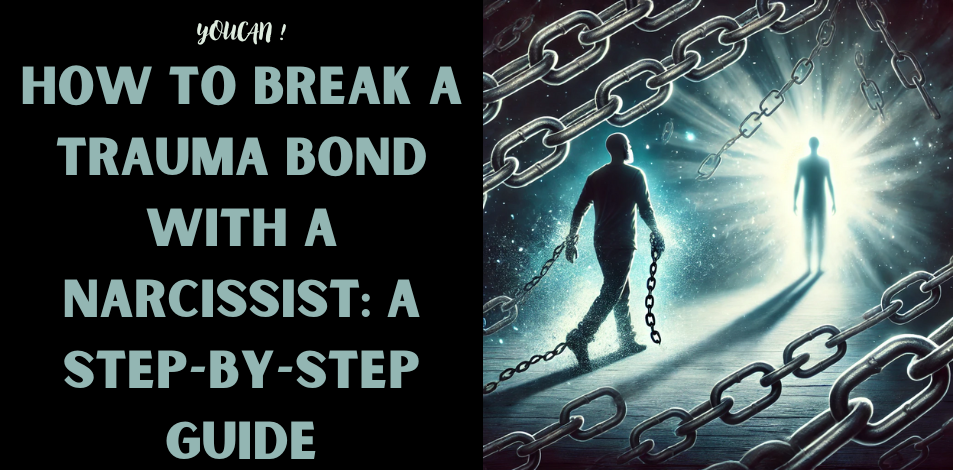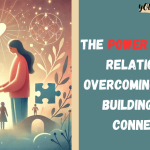
Breaking free from a trauma bond with a narcissist can seem like an insurmountable challenge, especially when emotions, manipulation, and confusion are so deeply intertwined. If you’re reading this, you’re likely trying to figure out how to break away from someone who has held you in their emotional grip. The good news is that healing is possible. In this article, we’ll explore practical steps to help you break this bond, reclaim your sense of self, and begin a new chapter in your life.
What is a Trauma Bond?
Before we delve into how to break a trauma bond, it’s important to understand what it is. A trauma bond occurs when an individual forms an emotional attachment to someone who has abused, manipulated, or mistreated them, often in a cycle of ups and downs. With narcissists, this cycle can be especially powerful. They may alternate between periods of emotional abuse and moments of charm or affection, creating confusion and deep emotional dependency.
Why is it so hard to break free?
The dynamics of trauma bonding are complex. Narcissists are adept at exploiting your vulnerabilities, using tactics like manipulation, guilt tripping, and love bombing to keep you hooked. Here’s why it’s so hard to break free:
Emotional manipulation: Narcissists know how to make you feel special, only to tear you down later. This constant push and pull can leave you feeling emotionally drained but unable to leave.
Fear of abandonment: Narcissists often exploit your fear of being alone or unworthy. This fear can make you feel like you’ll never find someone else who can “love” you the way they do, keeping you stuck in the relationship.
Cognitive dissonance: Narcissists thrive on confusion. Their inconsistent behavior—alternating between love and cruelty—makes you question your own reality. This self-doubt can make it incredibly difficult to see things clearly.
Now, let’s go over the practical steps you can take to break free from the bond of trauma and begin healing.
Step 1: Acknowledge the Reality
The first step in breaking the trauma bond is to acknowledge that the relationship is toxic. Narcissists are master manipulators, and they can make you question your perception of events. They may convince you that you’re overreacting, that things aren’t as bad as you think, or that you’re the problem.
To break free, you must face the truth: the relationship is destructive. Realize that the narcissist’s behavior isn’t your fault. The love they’ve shown you isn’t real love—it’s manipulation.
Step 2: Set Boundaries
Setting boundaries is crucial to breaking the trauma bond. Narcissists are notorious for pushing boundaries and testing boundaries, so it’s important to set clear lines that protect your emotional and physical safety.
Here’s how to set boundaries with a narcissist:
Limit Contact: If you can, limit the amount of contact you have with the narcissist. This may mean no contact, or if that’s not possible, setting strict guidelines for contact. Keep communication brief and focused on practical matters, such as finances or children, if necessary.
Be assertive: Narcissists will test your boundaries, so it’s important to remain assertive. If they try to manipulate you into breaking your boundaries, stay firm. Practice saying “no” and sticking to them.
Be consistent: Consistency is key. Narcissists thrive on inconsistency, so keep your boundaries clear and reiterate them when necessary.
Step 3: Rebuild Your Sense of Self
Narcissists often try to erode your sense of self-worth. They may tell you that you’re not good enough, that you’re not worthy of love, or that no one else will ever care for you. Over time, these messages can become ingrained in your mind, making it difficult to imagine life without them.
Rebuilding your sense of self involves focusing on what makes you feel whole. Here are some ways to do this:
Engage in self-care: Take time to nurture yourself. Engage in activities that bring you joy and fulfillment, whether it’s a hobby, exercise, meditation, or spending time with loved ones.
Identify your strengths: Write down your strengths, accomplishments, and the positive qualities that make you who you are. Remind yourself of your value and what you bring to the world.
Seek support: Surround yourself with people who care about you and lift you up. Reach out to friends, family, or a support group that understands what you’ve been through.
Step 4: Seek professional help
Breaking the bond of trauma isn’t something you have to do alone. Narcissistic abuse can be emotionally devastating, and healing often requires professional support. A therapist who specializes in trauma or narcissistic abuse can help you untangle the complex emotions and behaviors associated with the bond.
Therapy can help you:
Process your emotions: Talking about your experience with a professional can help you process the pain, confusion, and guilt that may arise during your healing journey.
Develop healthy coping strategies: A therapist can help you develop strategies to manage the stress, anxiety, and triggers that may arise when the bond is broken.
Build resilience: Therapy can help you build emotional resilience, empowering you to move forward with strength and confidence.
See also: 7 Narcissistic Behaviors That Might Fly Under Your Radar
Step 5: Break the Narcissist’s Control
Narcissists often use tactics like emotional manipulation, emotional blackmail, and isolation to keep you under their control. Breaking the trauma bond requires you to regain control of your life, which means cutting off their ability to manipulate or control you.
Here’s how to do it:
No Contact: If possible, cut off contact completely. Block them on social media, change your phone number, and avoid any interaction that allows them to manipulate you.
Grey Rock Method: If you must interact (for example, if you have children together or have business dealings), use the Grey Rock Method. This involves being as emotionally unresponsive and uninteresting as possible, making you less likely to be manipulated. Don’t engage in arguments: Narcissists thrive on arguments and conflict. Avoid engaging in fights or discussions that allow them to twist the narrative. Keep your responses short, direct, and emotionless.
Step 6: Create a Support System
Breaking the trauma bond can be lonely, especially when the narcissist isolates you from friends and family. Now is the time to rebuild your support system.
Connect with trusted people: Reconnect with people who truly care about you. They can provide emotional support, encouragement, and a sense of belonging.
Join a support group: Consider joining an online or in-person support group for survivors of narcissistic abuse. Listening to others who have gone through similar experiences can help you feel less isolated and more understood.
Surround yourself with positivity: Spend time with people who lift you up. Avoid anyone who reinforces negative beliefs about yourself or makes you feel guilty for leaving the narcissist.
Step 7: Embrace your healing journey
Breaking the trauma bond with a narcissist is not an overnight process. It takes time, patience, and perseverance. There will be moments of doubt, but remember that healing is not linear—it’s a journey with ups and downs. Celebrate small victories and give yourself some peace as you go through this process.
Conclusion
Breaking the trauma bond with a narcissist requires you to take a step back and reclaim your power. It’s about acknowledging the manipulation, setting boundaries, rebuilding your self-esteem, and seeking the support you need to heal. While it may seem overwhelming, remember that you are stronger than you think. By taking these steps, you will begin to untangle yourself from the narcissist’s emotional grip and begin the process of reclaiming your life. Keep moving forward—you have this.
Read more: How the Narcissist Plays the Hero in Their Own Story




